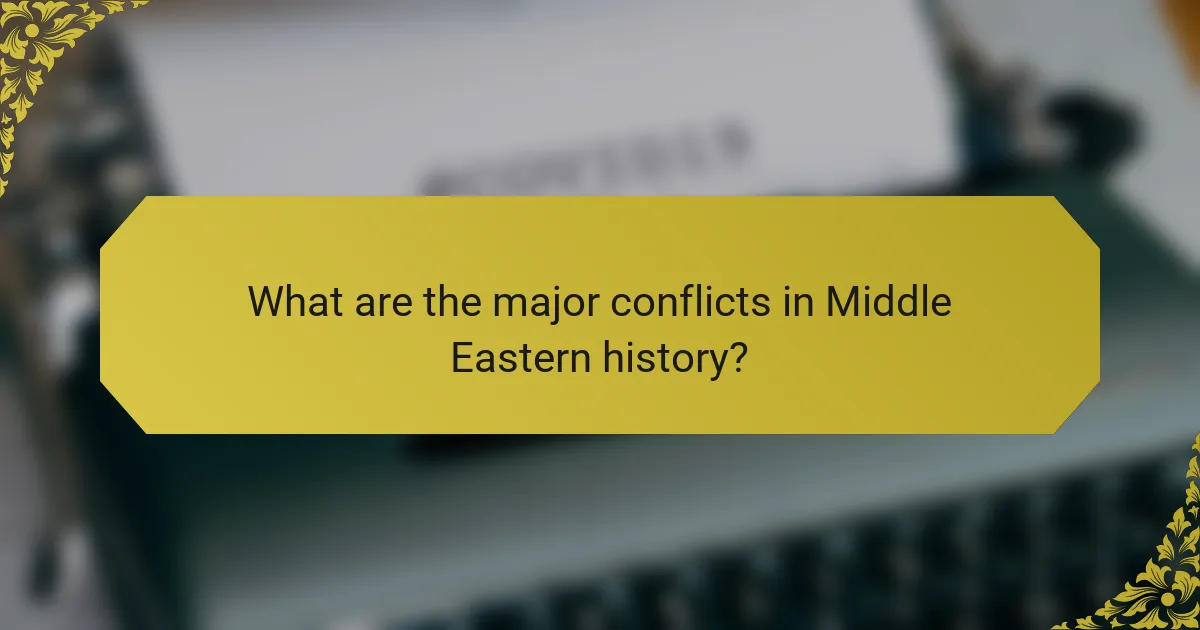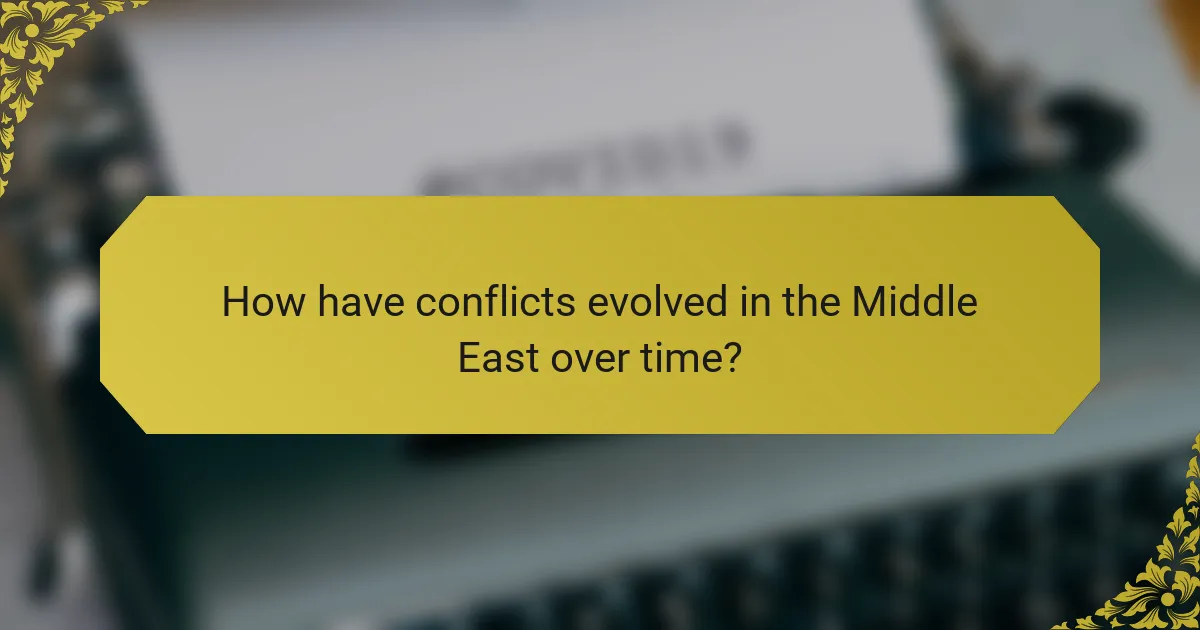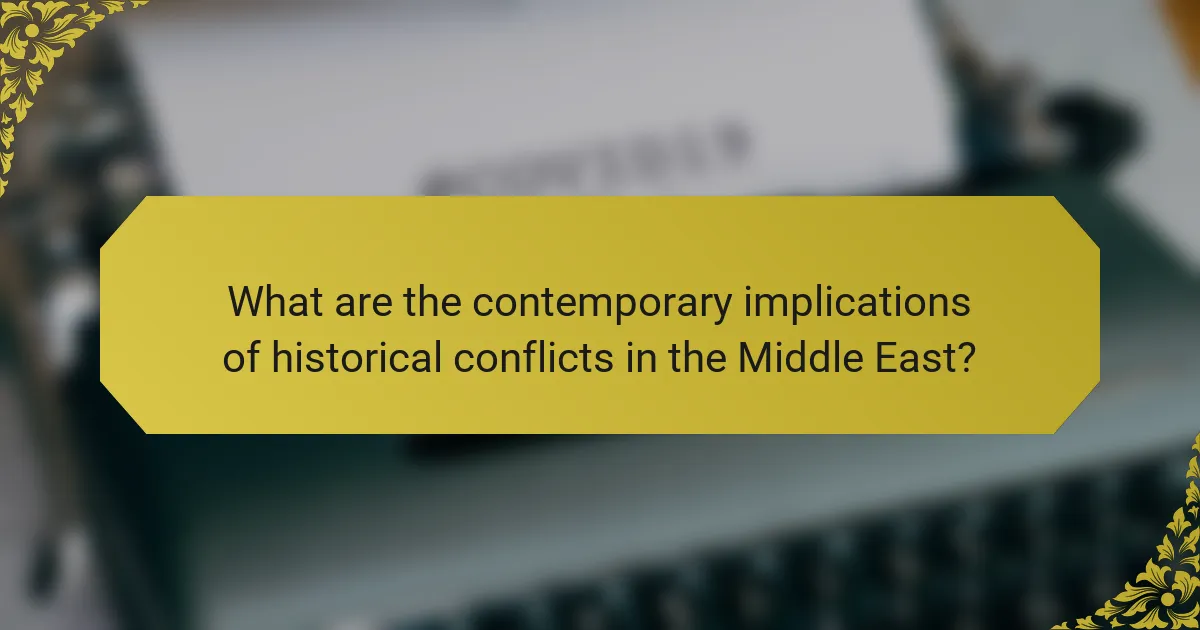
What are the major conflicts in Middle Eastern history?
The major conflicts in Middle Eastern history include the Arab-Israeli conflict, the Iran-Iraq War, and the Syrian Civil War. The Arab-Israeli conflict began in the mid-20th century, rooted in territorial disputes and national identities. The conflict has led to several wars, including the 1948 Arab-Israeli War and the 1967 Six-Day War. The Iran-Iraq War lasted from 1980 to 1988, resulting in significant casualties and economic damage for both countries. The Syrian Civil War started in 2011, stemming from anti-government protests and evolving into a complex multi-faceted conflict. Other notable conflicts include the Gulf War and the ongoing tensions in Yemen. These conflicts have shaped the political landscape of the region significantly.
What historical events are considered major conflicts in this region?
Major conflicts in the Middle East include the Arab-Israeli conflict, the Iran-Iraq War, and the Gulf War. The Arab-Israeli conflict began in the mid-20th century, stemming from territorial disputes and national identity. The Iran-Iraq War lasted from 1980 to 1988, resulting in significant casualties and economic damage for both nations. The Gulf War occurred in 1990-1991, triggered by Iraq’s invasion of Kuwait, leading to a coalition response and Iraq’s eventual withdrawal. Other notable conflicts include the Syrian Civil War, which started in 2011, and the ongoing tensions in Yemen. These conflicts have shaped the political landscape and social dynamics of the region.
How did the Arab-Israeli conflict shape the geopolitics of the Middle East?
The Arab-Israeli conflict significantly shaped the geopolitics of the Middle East. It created enduring tensions between Israel and its Arab neighbors. The conflict has influenced regional alliances and enmities. For instance, the 1948 Arab-Israeli War led to the establishment of Israel and the displacement of Palestinian Arabs. This displacement fueled ongoing disputes over territory and national identity. The conflict also prompted the rise of various political movements, such as Pan-Arabism and Islamism. Additionally, it has drawn in global powers, impacting U.S. and Soviet involvement in the region during the Cold War. The peace process, including the Camp David Accords in 1978, attempted to address these tensions but has seen limited success. Overall, the Arab-Israeli conflict remains a central issue in Middle Eastern politics, affecting security, diplomacy, and economic relations among states.
What role did the Iran-Iraq War play in regional stability?
The Iran-Iraq War significantly destabilized the Middle East region. The conflict lasted from 1980 to 1988 and resulted in massive casualties and economic destruction. It heightened tensions among neighboring countries, particularly concerning territorial disputes and political ideologies. The war led to increased militarization in the region, as countries sought to bolster their defenses. Additionally, it created a power vacuum that encouraged the rise of extremist groups. The aftermath of the war also contributed to the Gulf War in 1990, further exacerbating regional instability. Overall, the Iran-Iraq War reshaped alliances and rivalries, leaving a lasting impact on Middle Eastern geopolitics.
What are the underlying causes of these conflicts?
Underlying causes of conflicts in Middle Eastern history include territorial disputes, ethnic tensions, and religious differences. Territorial disputes often arise from colonial legacies and arbitrary borders drawn during the 20th century. Ethnic tensions are prevalent between groups such as Arabs, Kurds, and Turks, leading to struggles for autonomy and recognition. Religious differences, particularly between Sunni and Shia Muslims, exacerbate existing tensions and contribute to violence. Additionally, competition for resources, including water and oil, fuels conflicts. Historical grievances and foreign interventions further complicate these issues, creating a cycle of violence and retaliation. These factors collectively contribute to the ongoing instability in the region.
How do religious differences contribute to conflicts in the Middle East?
Religious differences significantly contribute to conflicts in the Middle East. The region is home to various religious groups, primarily [censured], [censured], and Judaism. Historical disputes over holy sites and religious interpretations often lead to tensions. Sunni and Shia [censured] represent the largest divide within the Muslim community. This division has sparked numerous conflicts, including the ongoing violence in Iraq and Syria. Religious identity often intertwines with national and ethnic identity, exacerbating conflicts. For instance, the Israeli-Palestinian conflict is deeply rooted in religious claims to land. Additionally, extremist groups exploit religious differences to justify violence. These dynamics create a cycle of conflict that is difficult to resolve.
What impact do colonial legacies have on contemporary conflicts?
Colonial legacies significantly influence contemporary conflicts in the Middle East. These legacies often manifest through arbitrary borders drawn by colonial powers. Such borders frequently ignore ethnic and sectarian divides, leading to tensions among various groups. For instance, the Sykes-Picot Agreement of 1916 established borders that did not reflect the region’s complex demographics. This has resulted in ongoing disputes and violence, particularly in Iraq and Syria. Additionally, colonial rule fostered authoritarian regimes that suppressed dissent. This suppression has contributed to civil unrest and uprisings, such as the Arab Spring. Furthermore, the economic exploitation during colonial times created long-lasting inequalities. These economic disparities continue to fuel grievances and conflicts today. Overall, colonial legacies are deeply embedded in the socio-political fabric of the region, perpetuating cycles of conflict.
What resolutions have been attempted in these conflicts?
Numerous resolutions have been attempted in major conflicts in Middle Eastern history. Peace treaties have been signed, such as the Camp David Accords in 1978 between Egypt and Israel. The Oslo Accords in the 1990s aimed to resolve the Israeli-Palestinian conflict through a two-state solution. International mediations, including the Quartet on the Middle East, have sought to facilitate dialogue among conflicting parties. Ceasefires have been brokered during various wars, such as the Lebanon War in 2006. Diplomatic efforts by countries like the United States and Russia have aimed to stabilize the region. Additionally, regional organizations like the Arab League have attempted to mediate disputes among member states. These resolutions reflect ongoing efforts to address complex historical grievances and achieve lasting peace.
How effective have peace treaties been in the Middle East?
Peace treaties in the Middle East have had mixed effectiveness. Some treaties, like the Camp David Accords in 1978, led to lasting peace between Egypt and Israel. This agreement resulted in the return of the Sinai Peninsula to Egypt and established diplomatic relations. Other treaties, such as the Oslo Accords in the 1990s, aimed to resolve the Israeli-Palestinian conflict but have seen limited success. Violence and tensions have persisted despite these agreements. The effectiveness of peace treaties often hinges on political will and regional dynamics. Additionally, some treaties have faced challenges due to lack of enforcement mechanisms. Overall, while some treaties have achieved specific goals, many have failed to create lasting stability.
What role do international organizations play in conflict resolution?
International organizations play a crucial role in conflict resolution by facilitating dialogue and negotiations. They provide platforms for conflicting parties to communicate and reach agreements. Organizations like the United Nations often deploy peacekeeping missions to stabilize regions post-conflict. They also offer mediation services to help resolve disputes peacefully. Historical examples include the UN’s involvement in the Israeli-Palestinian conflict. Their efforts have led to various peace treaties and resolutions aimed at reducing hostilities. Additionally, international organizations can impose sanctions to encourage compliance with peace agreements. Their influence helps to legitimize peace processes and garner international support.

How have conflicts evolved in the Middle East over time?
Conflicts in the Middle East have evolved significantly over time due to political, religious, and territorial disputes. Initially, ancient rivalries existed among city-states and empires, such as the Sumerians and Akkadians. The rise of [censured] in the 7th century introduced new religious dimensions to conflicts, leading to the Sunni-Shia split. In the 20th century, colonialism and the establishment of Israel in 1948 intensified regional tensions. The Arab-Israeli wars, particularly in 1967 and 1973, marked significant escalations. The Iranian Revolution in 1979 added another layer of complexity, influencing sectarian divides. The Gulf War in 1990-1991 showcased the geopolitical stakes in the region. More recently, the Syrian Civil War, beginning in 2011, has highlighted the ongoing struggles for power and influence. Each phase of conflict has been shaped by historical grievances, external interventions, and shifting alliances.
What patterns can be observed in the evolution of these conflicts?
Patterns observed in the evolution of conflicts in Middle Eastern history include recurring cycles of violence and peace. Conflicts often arise from territorial disputes, ethnic tensions, and resource competition. Historical instances, such as the Arab-Israeli conflict, exemplify prolonged hostilities followed by intermittent peace negotiations. The role of external powers frequently influences conflict escalation and resolution. For example, foreign interventions have both exacerbated tensions and facilitated peace processes. Additionally, shifts in political regimes often lead to new conflicts or the resurgence of old ones. The rise of non-state actors has also altered traditional conflict dynamics, introducing new challenges to stability. Overall, these patterns highlight the complex interplay of local and international factors in shaping conflict trajectories.
How have shifts in political power influenced conflict dynamics?
Shifts in political power significantly influence conflict dynamics by altering alliances, resources, and governance structures. For instance, the Arab Spring led to regime changes in several Middle Eastern countries. These changes often resulted in power vacuums, escalating tensions among various factions. In Libya, the overthrow of Muammar Gaddafi in 2011 created a fragmented political landscape, leading to ongoing civil conflict. Similarly, the rise of ISIS was facilitated by the instability following the U.S. invasion of Iraq and the subsequent power shift. Historical data shows that changes in leadership often correlate with increased violence and instability. The Syrian civil war exemplifies how shifts in political power can lead to prolonged conflict, as various groups vie for control. Overall, political power dynamics are critical in shaping the nature and intensity of conflicts in the region.
What impact has globalization had on Middle Eastern conflicts?
Globalization has intensified Middle Eastern conflicts through increased foreign intervention and the spread of extremist ideologies. The interconnectedness of economies and cultures has led to greater involvement of global powers in regional disputes. For example, the U.S. invasion of Iraq in 2003 was influenced by global political dynamics. Additionally, globalization facilitates the rapid dissemination of information, which can exacerbate tensions. Social media platforms enable extremist groups to recruit and spread propaganda widely. Economic globalization has also resulted in disparities that fuel resentment and unrest. The Arab Spring, which began in 2010, was partly driven by global economic conditions and social media mobilization. These factors illustrate how globalization has reshaped the landscape of conflicts in the Middle East.
What lessons have been learned from past conflicts?
Lessons learned from past conflicts include the importance of diplomacy and negotiation. Historical events, such as the Camp David Accords in 1978, illustrate that dialogue can lead to peace. Additionally, the consequences of ignoring cultural and religious differences are evident in conflicts like the Iraq War. Misunderstanding these factors often exacerbates tensions. Moreover, the necessity of involving local stakeholders in peace processes has been highlighted by the failure of external interventions in places like Libya. Lastly, the significance of addressing economic disparities to prevent conflicts is underscored by the Arab Spring, which was driven by economic grievances.
How can historical conflicts inform current peace efforts?
Historical conflicts provide critical lessons for current peace efforts. They reveal the underlying causes of tensions, such as territorial disputes and resource competition. Understanding these factors can help negotiators address root issues rather than just symptoms. Historical case studies, like the Camp David Accords, illustrate successful conflict resolution strategies. They demonstrate the importance of dialogue and compromise. Moreover, analyzing past failures, such as the Oslo Accords, highlights potential pitfalls in peace processes. By learning from previous mistakes, current efforts can be better structured. Overall, the analysis of historical conflicts enriches the framework for achieving lasting peace.
What strategies have proven successful in resolving disputes?
Successful strategies for resolving disputes include negotiation, mediation, and arbitration. Negotiation allows parties to communicate directly to reach a mutually acceptable solution. Mediation involves a neutral third party facilitating dialogue between disputing parties. Arbitration provides a binding resolution by an impartial arbitrator after reviewing evidence and arguments. Historical examples demonstrate these strategies’ effectiveness. The Camp David Accords in 1978 utilized negotiation to establish peace between Egypt and Israel. The Oslo Accords in the 1990s involved mediation to address Israeli-Palestinian tensions. Arbitration has been used in international disputes, such as the 2000 ruling by the International Court of Justice regarding border conflicts. These strategies have consistently led to successful outcomes in various disputes.

What are the contemporary implications of historical conflicts in the Middle East?
Contemporary implications of historical conflicts in the Middle East include ongoing geopolitical tensions, sectarian violence, and refugee crises. Historical conflicts have shaped national identities and political landscapes. For instance, the Israeli-Palestinian conflict continues to influence regional stability and international relations. Sectarian divides, rooted in historical rivalries, fuel conflicts in countries like Iraq and Syria. Furthermore, millions of displaced individuals from these conflicts strain neighboring countries and global resources. Economic instability in the region often stems from the aftermath of these historical disputes. The legacy of colonialism and foreign intervention complicates peace efforts today. Historical grievances perpetuate cycles of violence and hinder reconciliation processes.
How do historical conflicts affect current political relations?
Historical conflicts shape current political relations by creating lasting animosities and alliances. For example, the Arab-Israeli conflict has influenced diplomatic ties in the Middle East for decades. Historical grievances often fuel nationalist sentiments and hinder peace negotiations. Countries involved in past conflicts may distrust each other, affecting trade and cooperation. Additionally, historical conflicts can lead to the formation of military alliances based on shared experiences. The legacy of events like the Iran-Iraq War continues to impact regional dynamics. Understanding these historical contexts is crucial for analyzing contemporary political landscapes.
What role does memory play in shaping national identities?
Memory plays a crucial role in shaping national identities by preserving collective experiences and narratives. It influences how communities perceive their history and their place in the world. Shared memories of significant events, such as wars or revolutions, foster a sense of belonging and unity among individuals. In the context of Middle Eastern history, memories of conflicts, such as the Arab-Israeli War, are pivotal in forming national consciousness. These memories often shape political ideologies and social movements. They can also lead to the creation of national myths that reinforce identity. For instance, the memory of resistance against colonial powers strengthens national pride. Overall, memory acts as a foundation for cultural heritage and national solidarity.
How do unresolved conflicts influence regional security today?
Unresolved conflicts significantly undermine regional security today. These conflicts create instability, leading to violence and terrorism. For instance, the Syrian civil war has spilled over into neighboring countries, exacerbating tensions. Additionally, unresolved territorial disputes, such as those between Israel and Palestine, fuel ongoing hostilities. The lack of resolution often results in military buildups and arms races. Countries may also form alliances based on perceived threats from unresolved conflicts. This dynamic can lead to proxy wars, further complicating regional security. As a result, diplomatic efforts are often hampered, prolonging instability.
What can be done to promote lasting peace in the region?
Promoting lasting peace in the region requires comprehensive diplomatic efforts. Engaging in dialogue among conflicting parties is essential. Establishing mutual trust can facilitate negotiations. Economic cooperation can create interdependence, reducing the likelihood of conflict. Education initiatives can foster understanding and tolerance among diverse communities. International mediation can provide impartial support for peace processes. Historical grievances must be addressed to heal past wounds. Long-term development programs can improve living conditions and stability.
What initiatives show promise in fostering dialogue and understanding?
Interfaith dialogue initiatives show promise in fostering dialogue and understanding. Programs such as the United Nations Alliance of Civilizations promote mutual respect among different cultures. The Abrahamic Reunion facilitates peaceful interactions among Jews, Christians, and Muslims. The Seeds of Peace organization empowers youth from conflict regions to engage in dialogue. Research indicates that these initiatives enhance empathy and reduce stereotypes. Studies show that participants in such programs report improved relationships and understanding. The effectiveness of these initiatives is supported by successful case studies in various Middle Eastern contexts.
How can local communities contribute to conflict resolution efforts?
Local communities can contribute to conflict resolution efforts by fostering dialogue and understanding among conflicting parties. They can create safe spaces for discussions, allowing individuals to express their grievances. Community leaders can mediate disputes, utilizing their local knowledge and influence. Collaborative projects can be initiated to promote unity and shared goals. Research indicates that grassroots initiatives often lead to sustainable peace. For instance, the “Local to Global” project highlighted successful local mediation in various Middle Eastern conflicts. Engaging youth in peacebuilding activities can also prevent future conflicts. Overall, local communities play a crucial role in establishing trust and cooperation in conflict resolution.
What are practical steps for understanding Middle Eastern conflicts?
To understand Middle Eastern conflicts, one should start with historical context. Research key events like the Sykes-Picot Agreement of 1916. This agreement divided Ottoman territories and laid the groundwork for modern borders. Next, examine the impact of colonialism on local populations. Colonial powers often disregarded ethnic and religious divisions.
Analyze the role of major conflicts such as the Arab-Israeli War. This conflict began in 1948 and has ongoing implications. Study the influence of external powers, including the United States and Russia. Their involvement often escalates tensions and complicates resolutions.
Engage with diverse perspectives from local communities. Listening to voices from various ethnic and religious groups is crucial. Utilize reputable sources for information, such as academic journals and books. These sources provide in-depth analysis and factual data.
Lastly, stay updated with current events. Understanding ongoing developments helps contextualize historical issues. Following reliable news outlets can provide real-time insights into the region’s dynamics.
The main entity of the article is the major conflicts and resolutions in Middle Eastern history. It explores significant conflicts such as the Arab-Israeli conflict, the Iran-Iraq War, and the Syrian Civil War, detailing their historical contexts, underlying causes, and impacts on regional stability. The article also examines the evolution of these conflicts over time, the role of colonial legacies, and the effectiveness of various peace treaties and international mediation efforts. Additionally, it highlights the contemporary implications of historical conflicts on current political relations and regional security, as well as strategies for promoting lasting peace through dialogue and community engagement.


